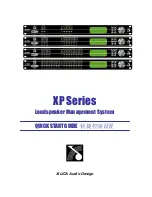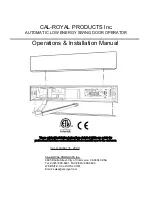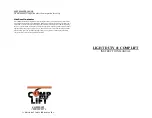
20/07/16 M37 (TS) EN
ENGLISH
ENGLISH
M
37
UsE As gEnErAtor
EngInE DrIVEn WELDErs
REV
.0-07/16
The electricity-generating groups are to be considered electrical
energy producing stations. The dangers of electrical energy
must be considered together with those related to the presence
of chemical substances (fuels, oils, etc.), rotating parts and
waste products (fumes, discharge gases, heat, etc.).
GENERATION IN AC (ALTERNATING CURRENT)
Before each work session check the efficiency of the ground
connection for the electricity-generating group if the distribution
system adopted requires it, such as, for example, the TT and
TN systems.
Check that the electrical specifications for the units to be
powered - voltage, power, frequency - are compatible with those
of the generator. Values that are too high or too low for voltage
and frequency can damage electrical equipment irreparably.
In some cases, for the powering of three-phase loads, it is
necessary to ensure that the cyclic direction of the phases
corresponds to the installation’s requirements.
Connect the electric devices to be powered to the AC sockets,
using suitable plugs and cables in prime condition.
Before starting up the group, make certain no dangerous
situations exist on the installation to be powered.
Check that the thermal-magnetic switch (Z2) is in the OFF
position (input lever in downward position).
Start up the electricity-generating group, positioning the thermal-
magnetic switch (Z2) and differential switch (D) to ON (input
lever in upward position).
Before powering on the utilities, check that the voltmeter (N)
and frequency meter (E2) indicate nominal values; in addition,
check on the voltmeter change-over switch (H2) (where it is
assembled) that the three line voltages are the same.
In the absence of a load, the values for voltage and frequency
can be greater than their nominal values. See sections on
VOLTAGE and FREQUENCY.
OPERATING CONDITIONS
POWER
The electrical power expressed in kVA on an electricity-
generating group is the available output power to the reference
environmental conditions and nominal values for: voltage,
frequency, power factors (cos
ϕ
).
During the use of the electricity-generating group NEVER
EXCEED the power indications, paying careful attention when
several loads are powered simultaneously.
VOLTAGE
In some types of generators (asynchronous) the no-load vol-
tage can be even higher than 10% with respect to its nominal
value; for example, for nominal voltage, three-phase 400Vac
or single-phase 230Vac, the no-load voltage can be between
425-440V (three-phase) and 240-252V (single-phase).
The full load voltage could also be 10% lower than its nominal
value with balanced loads and with a rotation speed variation
of less than 4%.
FREQUENCY
The frequency is a parameter that is directly dependent on the
motor’s rotation speed. Depending on the type of alternator, 2
or 4 pole, we will have a frequency of 50/60 Hz with a rotation
speed of 3000/3600 or 1500/1800 revolutions per minute.
The frequency, and therefore the number of motor revolutions,
is maintained constant by the motor’s speed regulation system.
Generally, this regulator is of a mechanical type and presents
a droop from no-load to nominal load which is less than 5
% (static or droop), while under static conditions precision is
maintained within ±1%.Therefore, for generators at 50Hz the
no-load frequency can be 52–52.5 Hz, while for generators at
60Hz the no-load frequency can be 62.5-63Hz.
In some motors or for special requirements the speed regulator
is electronic; in these cases, precision under static operating
conditions attains ±0.25%, and the frequency is maintained
constant in operation from no-load to load (isochronal operation).
POWER FACTOR - COS
ϕ
The power factor is a value which depends on the load’s
electrical specifications; it indicates the ratio between the Active
Power (kW) and Apparent Power (kVA). The apparent power is
the total power necessary for the load, achieved from the sum
of the active power supplied by the motor (after the alternator
has transformed the mechanical power into electrical power),
and the Reactive Power (kVAR) supplied by the alternator. The
nominal value for the power factor is cos
ϕ
= 0,8; for different
values comprised between 0.8 and 1 it is important during
usage not to exceed the declared active power (kW), so as to
not overload the electricity-generating group motor; the apparent
power (kVA) will diminish proportionally to the increase of cos
ϕ
.
For cos
ϕ
values of less than 0.8 the alternator must be
downgraded, since at equal apparent power the alternator
should supply a greater reactive power. For reduction
coefficients, contact the Technical Service Department
.
STARTING ELECTRIC MOTORS
The starting of electric motors by a generator can be critical
due to the high starting currents that the electric motor requi-
res (Iavv. = Up to 8-10 times the rated current In.).
With asynchronous alternators, the motor starting current
must not exceed the rated current of the alternator, which is
why asynchronous alternators are not recommended for star-
ting electric motors.
Access forbidden to area adjacent to electricity-
generating group for all non-authorized personnel.
WARNING
It is absolutely forbidden to connect the unit to the public
mains and/or another electrical power source .
WARNING
For the canopy generator sets provided with doors, the
following instruction shall be observed. During the normal
operation, the doors of the engine compartment and/or the
electrical box shall be kept closed, locked up if possible, as
they must be considered in all respects as protection barriers.
The access to the internal parts shall occur for maintenance
purposes only, by qualified personnel and, in any case, when
the engine is stopped.
!
!
29
Содержание TS 400 YS
Страница 2: ......
Страница 40: ...11 01 01 Note NOTE 46...
Страница 41: ...11 01 01 Note NOTE 46...
Страница 42: ...11 01 01 Note NOTE 46...
Страница 43: ......
















































